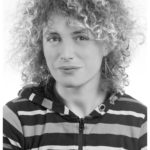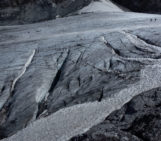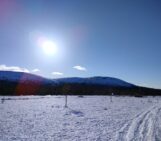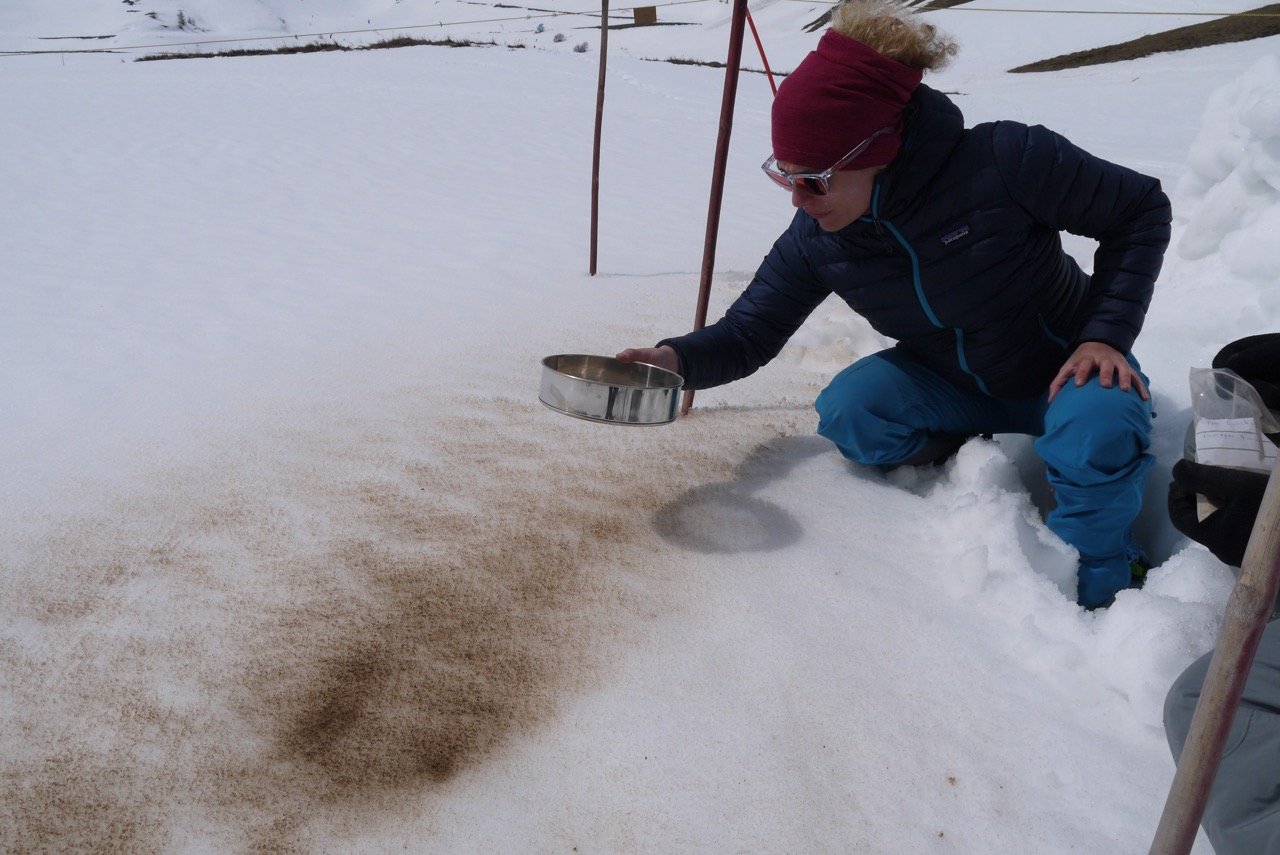
Snow! Here, Marie is spreading mineral dust on natural snow to investigate how this will change snow evolution (Col du Lautaret, France) [Credit : Maxim Lamare]
This week, we are interviewing Dr Marie Dumont. At the European Geosciences Union (EGU) general assembly in 2019, Marie was awarded the Arne Richter Award for Outstanding Early Career Scientist. Marie is currently a research team leader and deputy scientific director for the Snow Research Centre (part of Centre National de Recherches Meteorologiques, Météo-France & Le Centre national de la Recherche Scientifique [CNRS]) in France. Here, we ask her questions to find out a little more about the snow scientist.
Let’s start off with an easy question: what is it that you work on?
My researches are about the optical properties of snow, aka as the color of snow for the visible wavelengths. The “color” of snow is both cause and an effect of the snow cover evolution, it controls a large part of the melt rate and triggers potent climate feedbacks. I am working on how to measure and model the optical properties of snow at differences length scales and how to use this knowledge to better predict the evolution of the snow cover, in the past, now and in the future.
Did you always know you wanted to be a scientist?
Tricky question! Maybe, I knew deep down inside of me. It popped up quite naturally in my career. I hesitated for a while between mountain sports and science, and for some reason (maybe education, maybe something else) I ended up with one being my job and the other being my hobby, so I am quite lucky!
What is it about snow that has inspired you (and prompted four uses of ‘snow’ in your twitter handle)?
Snow snow snow …
Snow is beauty and fairy-like, snow is complex and simple at the same time. To me, it makes everything look great and perfect. As far as I remember, I have always been fascinated by snow. It calms me down and makes me feel incredibly good and peaceful. Maybe, it has also something to do with the fact that snow is ephemeral and somehow bound to melt and disappear and also that it’s changing/evolving continuously, it’s never the same, never boring.
Jon Snow or actual snow?
Jon Snow cause “I know nuthin’”
Jon Snow, except in season 8 …**spoiler alert**.
Kidding … both. I was really happy to see that a worldwide success like Game of Thrones was using snow and winter as part of the (scary) story. In Game of Thrones, everyone is worrying that the world would end with winter coming. In reality, it was more the contrary. Naively, it made me happy to live in the fiction whilst winter was coming: it somehow distracted me from my sad thoughts on climate change and snow disappearance.
What worries you more: giving an award lecture at EGU, or panicking that you’ve left your tap running once you’ve left for fieldwork?
Giving an award lecture at EGU and knowing that I left the tap running when I left home for the conference… just kidding…. I think I am at bit of a scatterbrain, so I am quite used to leaving home with the tap running, losing my keys, my visa card and my passport. I don’t worry too much about that kind of thing anymore, it’s part of me and I am used to it.
On the contrary, I am not used to giving award lectures at all, so it worried me a lot, really a lot! I thought about it for quite a long time before EGU this year and the thing that worries me the most besides being in the limelight is the fact that I could possibly disappoint people that pushed me to get there and thus put their trust in me.
You’ve been very successful in both grant funding and winning awards, but what about times of less success? Do you have advice for any Early Career Scientists who’ve recently been rejected?
Usually only success is publicly reported. As anyone, I had, have and will have time of less success: rejected papers, rejected proposals, bad meetings, fully unsuccessful ideas, errors and conflicts with colleagues. I think I learnt, at least equally if not more, from errors and rejection than from success.
Advice? I’m not sure I am the right person to be giving any. This is a bit cliché but: keep trying, be passionate, be open to others, listen to them, listen to their comments and even when they are criticisms.
What do you crave/miss most when in remote locations?
My kids, friends and family, and after a few weeks a hot shower.
Do your kids have an interest in following in your footsteps (Marie is a mother of twins)?
Don’t know 😉 they are five years old! I brought them to one of my favourite field sites when they were two and taught them how to do a snow pit profile. For a while, they thought my job was about tasting snow J I am not really interested in the fact that they follow my footsteps or not. I just want, if I am able to do it, to show them how nature, wild places, and snow are beautiful and I think (ask me again in 10 years) that I would be happy if they are able to find their own passion about something and live it.
They could be the youngest early career scientists in the field of snow research! Do you think science has made advances in supporting women and parents in science? Are there still more things we can work on?
I am always a bit “torn” by this kind of question. On one hand, I think there has been a lot of advances in supporting parents and women in science, and I benefited from that a really a lot and it’s great!
On the other hand, in the push to promote male/female equality, I am always a bit puzzled by the emphasis that is put on supporting women only. There is something contradictory in this.
I think maybe it would make sense not to underline the differences too much. Getting funding, awards, sitting on committees is not all about quota, it should be mainly about skills. I am not at all saying that women, parents and other minorities should not be encouraged and offered new possibilities, as this is happening and is really great. However, there is a weight from history (more men than women in some science topics) that can’t disappear immediately and to some extent, I think pushing women only for quotas is harming the gender equality. Some women (I am part of them) may think they are successful only because of a quota. For example, I have encountered this argument:
XX : “Can you be part of this committee? Can you chair this or that?”
Me : “Why are you asking me ?”
XX: “Because you are a woman …”
Situations like this are frequent and in fact, it can make me quite angry.
You regularly participate and organise summer schools. Do you enjoy teaching? Do you have any advice for someone who might want to start teaching?
Not summer schools, winter schools of course!
I enjoy teaching but it’s also not a large part of my working time and I don’t have a huge experience in teaching. I enjoy teaching because I like sharing with students, learning about them, about their opinion … Advice? Same as above: listen to the students: as kids they teach you as much as you teach them, try to be funny and convincing!
As you spend lots of time in cold places for your work, do you prefer hot/beach holidays or do you still holiday in colder places?
Before having kids, it was really only about cold/mountain places. Now that I am getting older, I do also appreciate hot/beach holidays as long as I can climb or do some sports and that the places are wild and beautiful.
Day to day, what does being a scientist look like?
Coffee, taking kids to school, cycling to work, meetings (I need another coffee), emails, reviews, proposal writing, abstract writing (promising work that I know I will never be able to do before the conference), debugging some programs, discussing ideas with colleagues and students, ticking 2 things on my to-do list and adding 7 new items, trying to fit in two hours of pure science, asking for deadline extensions, meetings again, cycling back home… something like that.
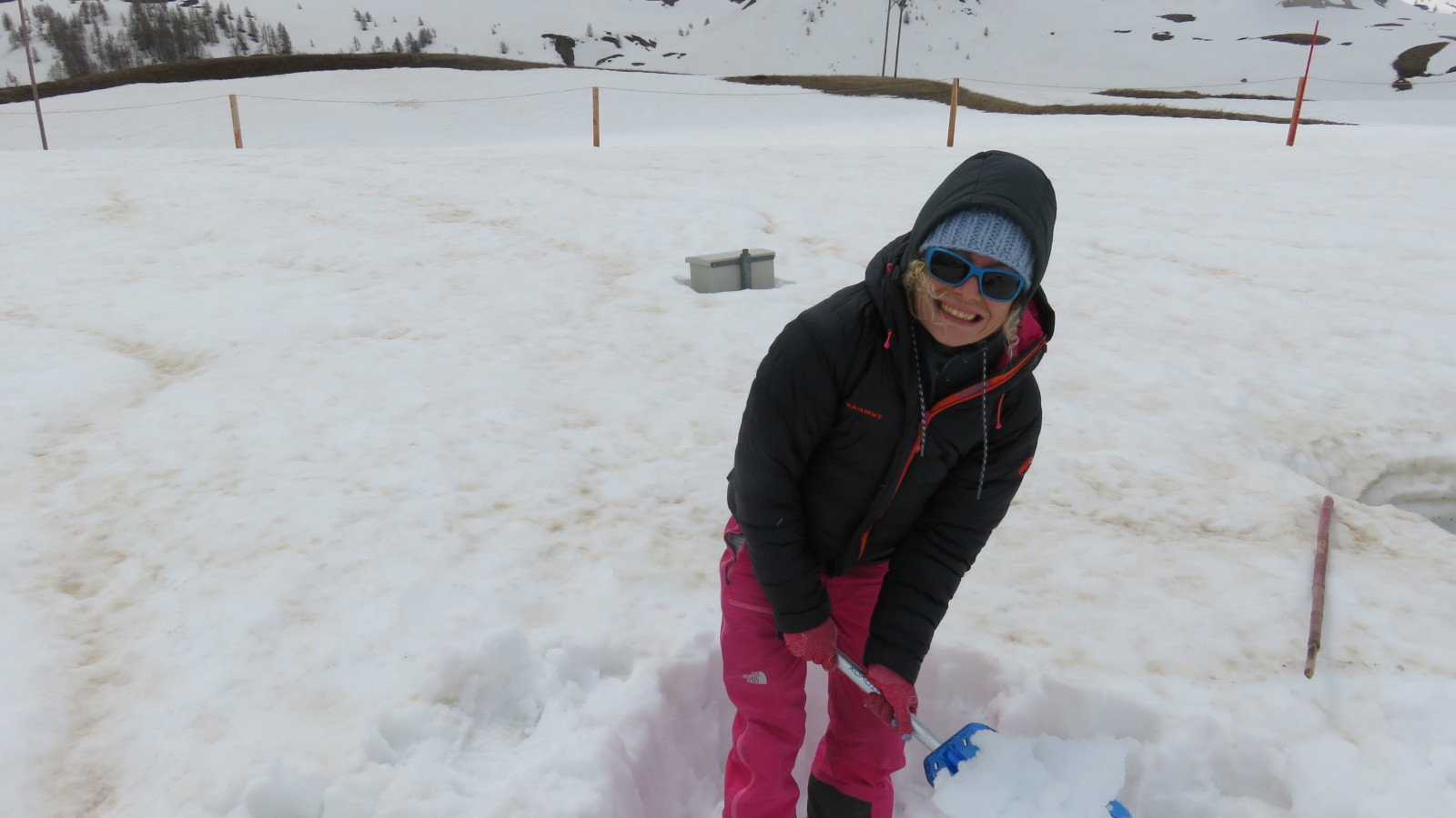
She might look happy but digging snow pits is hard work! Snow pits are often dug to allow scientists to look at the change in snow properties with depth (Col du Lautaret, France) [Credit: François Tuzet].
Top 10 awesome-science days/moments (with no preference):
- Field days (even the unsuccessful days and during bad weather)
- Sharing ideas and debating with colleagues/students when the understanding is beyond words
- Passionate science/equation discussions in weird places (carparks, planes, trains, …)
- Exciting new lab measurements that we still don’t know what they are useful for
- Friday beers when the discussion oscillates between what happened during the past week and what the plans for the weekend are
- Making at least one person laugh or smile in a conference talk with a nerdy joke
- Finally getting the figure that demonstrates the hypothesis we were convinced about for a while and realizing a few hours after that there was a bug in the plot routine.
- Finally finding the bug I was looking for after two weeks
- Working as a team
- Making nice figures with nice colours
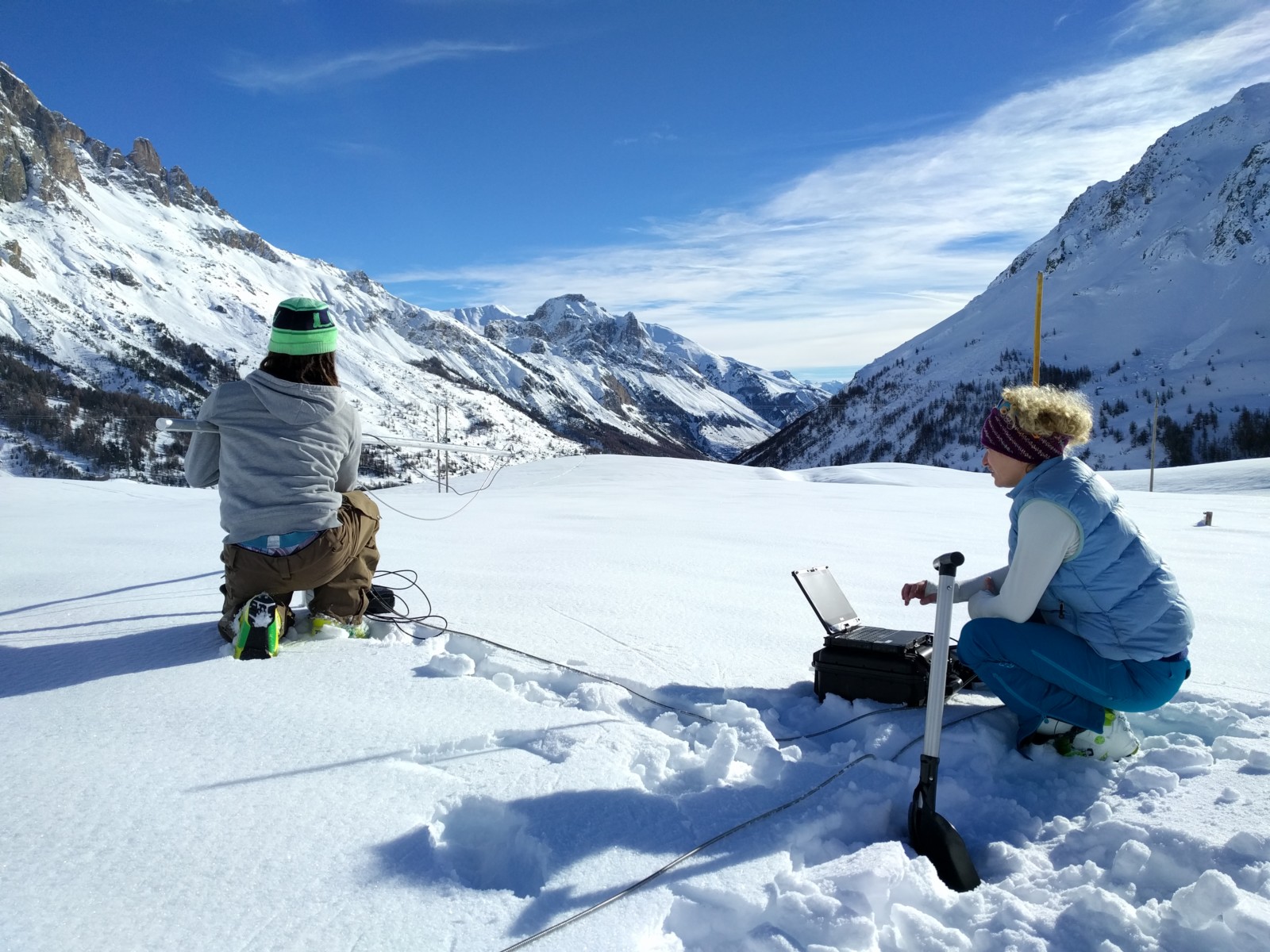
Fieldwork is a regular part of Marie’s scientific career. Here she is doing spectral albedo measurements with her PhD student, François Tuzet in Col du Lautaret, France. This instrument was developped by Laurent Arnaud and Ghislain Picard (IGE, Grenoble, France) [Credit: Mark Flanner].
We always love a nerdy science joke! What might be the next big break-through in your field? (E.g higher resolution satellite data or a new model or method of observing etc).
The next paper from my student 😉 kidding of course!
I think it’s a combination of the 3 points you mentioned. On one hand, temporal and spatial resolution of satellite data are getting better and better. For instance, the Sentinel satellites provide us unprecedented means to monitor the state of the snow cover. On the other hand, new observing methods (such as new instruments enabling observations of the snow properties at the microns/millimiters scales) provide new insights on snow evolution (in the lab and in the field) and snow physics that could be implemented in new snow models. So my vision, probably quite biased by what I currently plan to develop, is that a big break-through in snow science can probably be reached by developing modelling-assimilation systems that combine the most advanced knowledge of snow physics and the wealth of high resolution satellite data.
Model, satellite data or in-situ observations, you can only do one for the rest of time… which one?
Sorry, I can’t choose!
Ooo, we will let you off then. Afterall, science is about using the best techniques and data available. Thank you so much for chatting with us Marie!
Interviewed and edited by Jenny Turton
Dr Marie Dumont is a snow scientist at the Snow Research Centre in the Centre National de Recherches Meteorologiques (Météo-France & CNRS). This unit is also associated to the Observatoire des Sciences de l’Univers de Grenoble – OSUG and to Univ. Grenoble Alpes in France. Her research focuses on remote sensing and observations of optical snow properties, and uses a range of methods including data assimilation of observations into models and laboratory work. She tweets from @mpneige.


